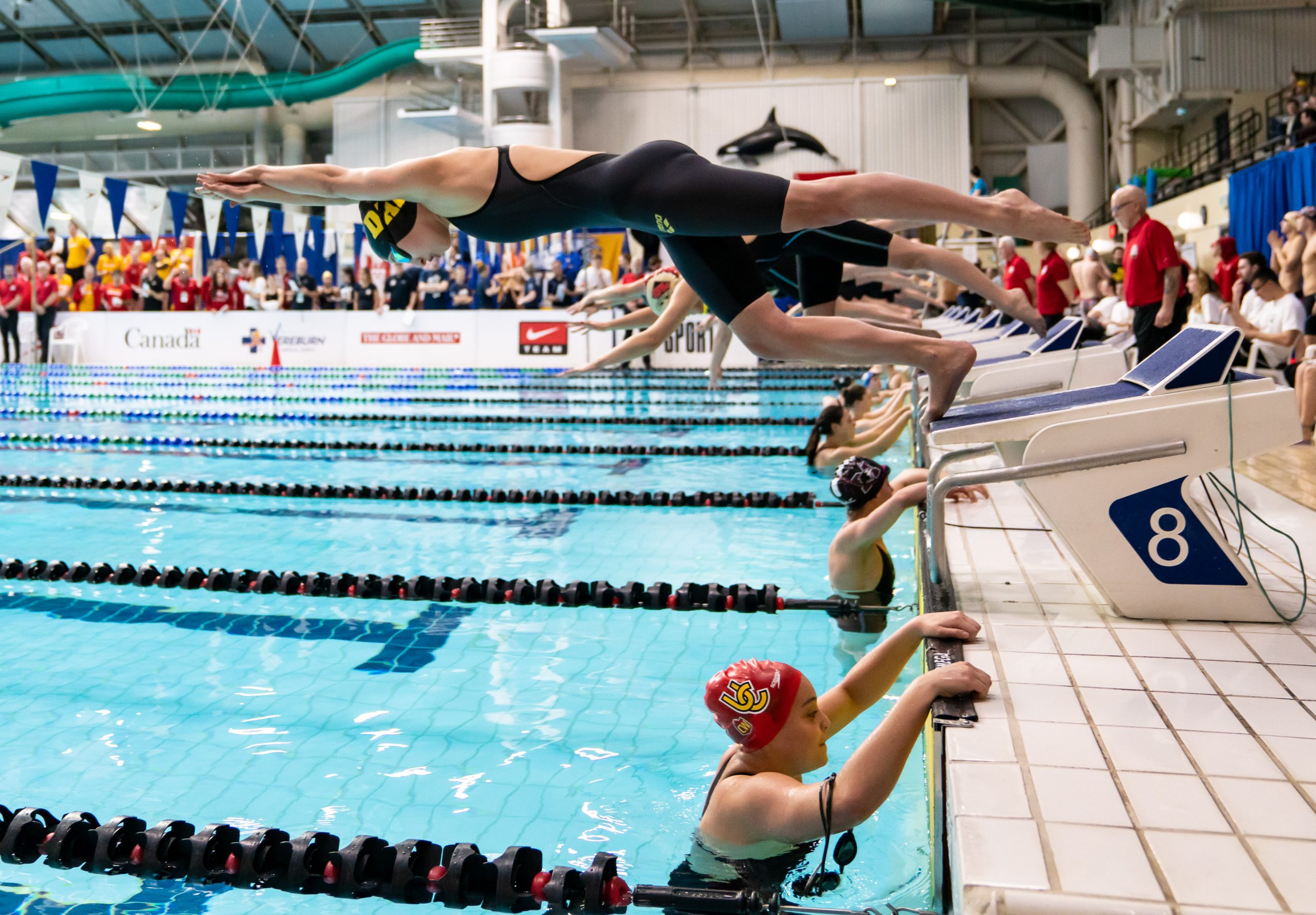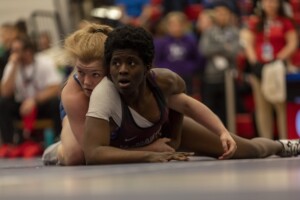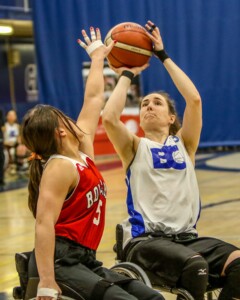
U SPORTS 2020 Swimming Championships at Saanich Commonwealth Place, Victoria, BC, February 2020 (Photo: U SPORTS)
Looking back over the last 50 years of women’s sport in Canada, it’s amazing how we have progressed to bring equity, stability, and opportunity, not necessarily in all aspects of sport, but certainly in many.
For example, 50 years ago women’s soccer in Canada was almost non-existent although there were signs of a growing interest among children and youth (Hall, 2004). Scattered girls’ teams began to appear in the late 1960s, which had the immediate effect of attracting mothers, who developed an interest in the game by becoming team managers and league administrators. Throughout the 1970s and 1980s, opportunities for girls to play soccer continued to proliferate in Canada.
Jumping ahead to the summer of 2023, Canada competed in the FIFA Women’s World Cup for the eighth time. That followed on the heels of the Canadian Women’s National Team winning the gold medal in soccer at the 2020 Tokyo Olympics. In 2022, Canada Soccer reported that of 575,768 youth players in the country, 38% were female, and today, soccer is still the fastest growing sport among Canadian youth (Canada Soccer, 2022).
The phenomenal growth in girls’ and women’s soccer in Canada is just one example of how significantly women’s sport has changed over the past 5 decades.
It is not possible to cover all aspects of women’s sport between 1973 and 2023 in this short article. Instead, I examine themes that are significant and still require our attention and diligence, namely, feminism, leadership, professional sport, and finally safe and inclusive sport. Others might have chosen different topics.
Feminism and women’s sport
What has been the role of feminism, broadly defined as the belief in full social, economic, and political equality for women, in creating change in Canadian women’s sport over the past 50 years? Although second-wave feminism emerged in Canada in the 1960s, it did not have a significant impact on sport until the 1970s when it became clear that unless women acted, they would be routinely sidelined.

Also, from a feminist perspective, the world of sport was often dismissed as male, competitive, and not crucial to the widespread effort of improving the status of women in Canada. This changed in 1981 with the formation of the Canadian Association for the Advancement of Women and Sport (CAAWS), which provided a feminist and safe place, where controversial and difficult topics, such as homophobia in women’s sport, could be addressed. Also important was the establishment of the federal government’s Women’s Program in Fitness and Amateur Sport. For more about this history, see Demers, Greaves, Kirby, & Lay, 2014.
The question now, more than 50 years after second-wave feminism entered the Canadian consciousness, is whether it remains a guiding factor in bringing about change within the sport system?
CAAWS, for example, was rebranded in 2020 as Canadian Women & Sport, and most frequently uses the phrase “gender equity” in its policy and promotional material. Over the past few years, there have been several parliamentary and governmental studies with subsequent reports concerning Canadian women and girls in sport. These include the Government of Canada’s Actively engaged: A policy on sport for women and girls (2009) and the Women and Girls in Sport Report of the Standing Committee on Canadian Heritage (2017).
The most comprehensive report, released in 2018, was the result of the Federal-Provincial/Territorial Sport Committee (FPTSC) Work Group on Women and Girls in Sport. It lays out a series of outcomes and accountability measures that, if followed, should ultimately result in “all women and girls being equally and equitably represented, recognized, and served across all facets of Canadian sport” (FPTSC Work Group on Women and Girls in Sport, 2018, p. 12).
These studies and reports provide a wealth of useful information, especially about how to bring about change in sport for girls and women. However, it is not clear who is making certain that recommendations are tracked and ultimately followed.
Women in sport leadership
Beyond participation, women have made strides in leadership roles within the Canadian sports sector, and the impact of female leaders has played an essential role in advancing gender equality in sports governance.
Beginning at the top, since 1961 there have been 34 federal ministers responsible for sport and physical activity, 10 of whom have been women, and half of these were appointed in the last 16 years.
Looking at the latest statistics for leadership in federally funded sport organizations in Canada is encouraging. A 2022 snapshot of National Sport Organizations (NSOs), national Multisport Service Organizations (MSOs), and Canadian Sport Institutes (CSIs), representing 90 organizations in total, showed that women comprised 41% of board membership, 38% of board chairs, and 47% of the CEOs. The highest percentage of women CEOs was among the MSOs (62%) and the lowest (29%) was in the CSIs (Canadian Women & Sport, 2022).
Similar statistics from the early 1980s showed that women comprised approximately one-third of the volunteer sport sector and only 26% of the professional sector (executive directors, technical directors, program coordinators, and national coaches). There were more women involved in the MSOs at the professional level (47%), but they represented only 18% of the volunteer sector (Hall & Richardson, 1982, p. 63). Therefore, over the past 40 years there has been considerable improvement, yet there is still some way to go to achieve gender equity.

As for women coaches, especially at the national level, the situation is not as promising. For example, of the 131 Canadian coaches at the Tokyo 2020 Summer Olympic Games, approximately 18% were female, which was down from 20% at the Rio Summer Olympics 4 years earlier. On the other hand, 47% of the Paralympic coaches in Tokyo were women. Forty years ago, 60% of women playing on a Canadian university team were coached by a man (Hall & Richardson, 1982, p. 62). Still today, most university coaches are men except for assistant coaching positions on women’s sport teams, held mostly by women (Finn, 2022).
More interventions are needed, like the Alberta Women in Sport Leadership Impact Program, by creating equitable coaching and leadership opportunities (Culver, Kraft, Din, & Cayer, 2019). While women continue to make outstanding contributions to Canada’s sport sector but remain significantly under-represented in coaching, there are organizations like the Coaching Association of Canada (CAC) that are working towards helping more women coach at all levels of sport through mentorship programs.
Professional women’s sport
When looking at the landscape 50 years ago, the opportunity for sport to provide women athletes with continuous paid employment and to pursue it as a career was next to nil. Golf, tennis, and figure skating were seasonal at best along with limited, semi-professional opportunities in sports like marathon swimming, roller derby, and car racing. There was also little potential for successful women athletes to earn money through endorsements and commercial ventures. As late as 1998, a parliamentary study of sport in Canada, which had a significant section on professional sport, made no mention of women (House of Commons, 1998). In other words, women’s professional sport was seen as unimportant.
While it is still not possible today for most Canadian women professional athletes, except in tennis, golf, and possibly figure skating, to make a living exclusively through their sport, there are encouraging signs that this will change. Especially in team sports like ice-hockey and soccer.
Even though a recent study argued that the current market for professional women’s sport in Canada is constrained by the lack of access to sustained professional sport properties like leagues, associations, or teams; this is slowly changing (Canadian Women & Sport, 2023). For example, a new North American women’s professional ice-hockey league is slated to begin in January 2024, and there are hopes of a Canadian women’s pro-soccer league by 2025. Canadian Tire has also announced a new multi-million-dollar Women’s Sport Initiative, earmarking a minimum of 50% of their sponsorship dollars towards women’s sport by 2026.
More high-profile events showcasing professional women athletes have also helped. For example, on May 23, 2023, the Chicago Sky and Minnesota Lynx of the Women’s National Basketball Association played the first-ever WNBA exhibition game held in Canada at the Scotiabank Arena in Toronto. It attracted a sell-out crowd and enthusiastic chatter about the expansion of the WNBA to Toronto.
A week prior, also in Toronto, the espnW Summit, hosted by Canadian Tire, brought together global “industry leaders, influencers, and disrupters” for an immersive 1-day session to push boundaries, spark action, and effect change. Attended almost entirely by women, it was a day full of engaging discussion and reflection into the advancements and opportunities for women in sport, leadership, and business (espnW Summit Canada, 2023). There was also considerable focus on the potential for women’s professional team sport in Canada.
Although these investments are encouraging and needed, media coverage in its various forms is also essential to the continued development and growth of women’s professional sport in Canada. While it has improved over the past 50 years with the help of women’s hockey and soccer, there is still a major imbalance between the reporting of men’s and women’s sports.
Safe and inclusive sport
Beginning in the early 1980s, the attitude towards sexual abuse in Canadian social institutions was changing from silence to scrutiny, reconciliation, and punishment, which encouraged researchers to study the problem in sport, and journalists to profile known cases and incidents, especially in women’s sport (see, for example, Kirby, Greaves, & Hankivsky, 2000, and Robinson, 2002).

By 1996, all NSOs receiving federal funding were required to develop a harassment policy, address complaints, and report annually to Sport Canada as a condition of funding. However, after 20 years, it was clear this self-monitoring policy was not working. In 2022, this prompted a new wave of athlete activism, resulting in the Office of the Sport Integrity Commissioner responsible for administering the Universal Code of Conduct to Prevent and Address Maltreatment in Sport.
Only time will tell if these new mechanisms are enough to stop the abuse. At its core, and as one researcher put it: “The safe sport movement is about optimizing the sport experience for all – athletes, coaches, sport administrators, officials, support staff, and others in the sport environment” (Kerr, 2021).
Not only must sport be safe, it must also be inclusive.
According to the latest census data, over half of Canada’s population (50.9%) identify as women. One in four Canadians identify as BIPOC (Black peoples, Indigenous peoples, and peoples of colour) and 1.7 million of these identify as Indigenous. Further, depending on different data sources, between 3% and 13% of Canadians identify as LGBTQ2S+ (Lesbian, Gay, Bisexual, Transgender, Queer or Questioning, or Two-Spirit).
The Canadian population of today, as compared to 50 years ago, includes more diverse individuals with intersectional identities. The reality is that low income and racialized persons, ethnic and religious minorities, newcomers, sexual minorities, and youth experiencing disabilities demonstrate the lowest levels of involvement and/or enjoyment in sport. This is particularly true for adolescent girls (Pegoraro & Moore, 2022; Hagger & Giles, 2022). Diversity, equity, and inclusion in Canadian sport means that all individuals should be treated with dignity and respect, and everyone has equal access to opportunities and resources.
Conclusion
By 2035, the Government of Canada is committed to achieving gender equality in Canadian sport at every level. In my opinion, this is unlikely to happen without a collaborative effort among governments and organizations devoted to bettering women’s sport. For example, Canadian Women & Sport partners with sport organizations, governments, and leaders to build better sport through gender equity. Their vision is to create an equitable and inclusive Canadian sport and physical activity system that empowers girls and women – as active participants and leaders – within and through sport. It remains to be seen whether, in little more than a decade, gender equality will have been accomplished in Canadian sport.
About the Author(s)
M. Ann Hall is a professor emerita in the Faculty of Kinesiology, Sport, and Recreation at the University of Alberta. She is the author of numerous books and articles about the history of women’s sport in Canada, including The Girl and the Game, 2nd Edition (University of Toronto Press, 2016).
References
Canada Soccer. (2022). Annual report. https://canadasoccer.com/wp-content/uploads/2023/05/CS_Annual-Report-2022-Web-EN.pdf
Canadian Centre for Ethics in Sport. (2018). Creating inclusive environments for trans participants in Canadian sport. Policy and practice template for sport organizations, https://cces.ca/sites/default/files/content/docs/pdf/cces-transinclusionpolicyguidance-e.pdf
Canadian Women & Sport. (2022). Women in sport leadership 2022 snapshot. https://womenandsport.ca/2021-2022-women-in-sport-leadership-snapshot/
Canadian Women & Sport. (2023). It’s time: A roadmap for accelerating professional women’s sport in Canada. https://womenandsport.ca/wp-content/uploads/2023/04/CWS-Its-Time-2023-April23.pdf
Culver, D. M., Kraft, E., Din, C., & Cayer, I. (2019). The Alberta women in sport leadership project: A social learning intervention for gender equity and leadership development. Women in Sport and Physical Activity Journal, 27(2), 110-117.
Demers, G., Greaves, L., Kirby, S., & Lay, M. (2014). Playing it forward: 50 years of women and sport in Canada. Toronto: Second Story Press.
espnW Summit Canada. (2023, May 12). https://espnwsummitcanada.ca/
Finn, H. (2022). Exploring the underrepresentation of women coaches in Canadian university Sport (Publication No. 29239008). [Doctoral dissertation, The University of Western Ontario]. ProQuest Dissertations and Theses Global.
FPTSC Work Group on Women and Girls in Sport. (2018). Recommendations report. https://sirc.ca/wp-content/uploads/2020/01/FPTSC-WG-WIS-Recommendation-Report-v14-Sept-27-2018-final.pdf
Government of Canada. (2009). Actively engaged: A policy on sport for women and girls. https://www.canada.ca/en/canadian-heritage/services/sport-policies-acts-regulations/policy-actively-engaged-women-girls.html
Haggar, A., & Giles, A. R. (2022). An intersectional analysis of the recruitment and participation of second-generation African Canadian adolescent girls in a community basketball program in Ottawa, Canada. Women in Sport and Physical Activity Journal, 30(2), 113-122.
Hall, M. A. (2004). The game of choice: Girls’ and women’s soccer in Canada.” In F. Hong &
Mangan, J.A. (Eds.), Soccer, women, sexual liberation: Kicking off a new era (pp. 30-46). London: Frank Cass.
Hall, M. A. & Richardson, D. A. (1982). Fair ball: Towards sex equality in Canadian sport. The Canadian Advisory Council on the Status of Women. Published also as Franc-Jeu: Vers l’egalite des sexes dans les sports au Canada.
House of Commons. (1998). Sport in Canada: Everybody’s business. Report of the Standing Committee on Canadian Heritage. https://www.ourcommons.ca/DocumentViewer/en/36-1/CHER/report-6/page-2
House of Commons. (2017). Women and girls in sport. Report of the Standing Committee on Canadian Heritage. https://www.ourcommons.ca/DocumentViewer/en/42-1/CHPC/report-7
Kirby, S., Greaves, L., & Hankivsky, O. (2000). The dome of silence: Sexual harassment and abuse in sport. Halifax: Fenwood.
Kerr, G. (2021, April 19). Next steps in the safe sport journey: From prevention of harm to optimizing experiences. https://sirc.ca/blog/next-steps-in-the-safe-sport-journey/
Pegoraro, A., & Moore, E. (2022, April 22). Signals versus noise: Gender equity in Canadian sport. https://sirc.ca/blog/signals-versus-noise/
Robinson, L. (2002). Black tights: Women, sport and sexuality. Toronto: HarperCollins.
The information presented in SIRC blogs and SIRCuit articles is accurate and reliable as of the date of publication. Developments that occur after the date of publication may impact the current accuracy of the information presented in a previously published blog or article.
